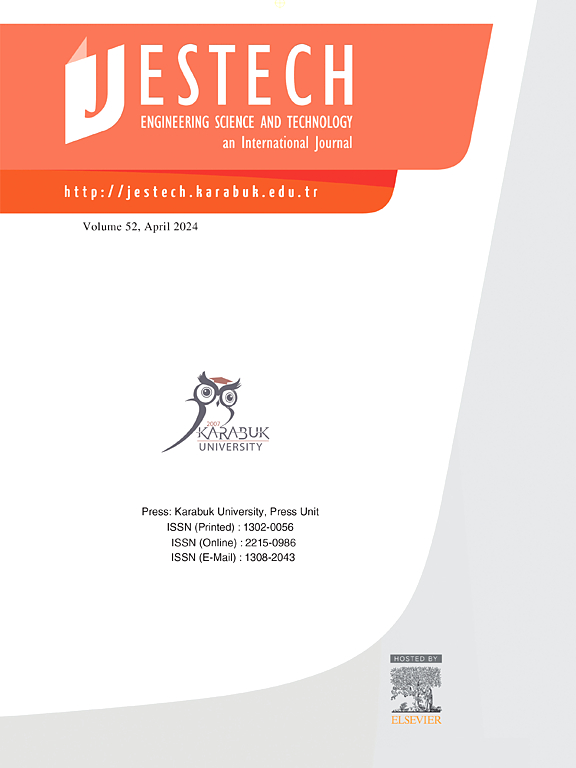玻璃窗上的透明金属表面增强了室内通信的5G毫米波传输
IF 5.4
2区 工程技术
Q1 ENGINEERING, MULTIDISCIPLINARY
Engineering Science and Technology-An International Journal-Jestech
Pub Date : 2025-06-27
DOI:10.1016/j.jestch.2025.102132
引用次数: 0
摘要
本研究提出了一种简单的带通频率选择表面(FSS)设计,可实现高光学透明度(OT),并增强5G室内无线通信中通过玻璃窗的毫米波传输。这些fss应用于玻璃窗,被称为玻璃穿透透明表面(gpss),采用元表面技术设计,在信号传播控制必不可少的环境中保持视觉上的不突兀。为了最大限度地提高工作效率,采用了一个简单的方形线图案和小型化的金属线。这些方形结构是级联的,以尽量减少金属区域对透明度的影响,创造了一个FSS,顶层是方形环,底层是由透明聚合物层分开的网格线。在低穿透损失和高穿透损失两种类型的玻璃窗上对所提出的GPTSs进行了评估。GPTS1具有更宽的铜线(100 μm),保持了64%的良好OT,并在n257和n261频段工作。此外,GPTS2采用更窄的铜线(30 μm),实现了81.4%的出色OT,并在n257, n258和n261频段工作。结果表明,所提出的FSS设计有望成为玻璃上毫米波信号滤波的有效解决方案。本文章由计算机程序翻译,如有差异,请以英文原文为准。

Transparent metal surfaces on glass windows enhance 5G mm-wave transmission for indoor communication
This study presents a straightforward design for a bandpass frequency selective surface (FSS) that achieves high optical transparency (OT) and enhances millimeter-wave transmission through glass windows for 5G indoor wireless communication. These FSSs, applied to glass windows and termed glass-penetrating transparent surfaces (GPTSs), are engineered with meta-surface technology to remain visually unobtrusive in environments where signal propagation control is essential. To maximize OT, a simple square-line pattern with miniaturized metal lines was employed. These square structures are cascaded to minimize the effect of the metal area on transparency, creating an FSS with a top layer of square loops and a bottom layer of grid wires separated by a transparent polymer layer. The proposed GPTSs were evaluated on two types of glass windows with low and high penetration losses. GPTS1, which features wider copper lines (100 μm), maintains good OT at 64 % and operates in the n257 and n261 frequency bands. In addition, GPTS2 employs narrower copper lines (30 μm), achieving an excellent OT of 81.4 %, and operating in the n257, n258, and n261 frequency bands. Results indicate that the proposed FSS designs hold promise as effective solutions for millimeter-wave signal filtering on glass windows.
求助全文
通过发布文献求助,成功后即可免费获取论文全文。
去求助
来源期刊

Engineering Science and Technology-An International Journal-Jestech
Materials Science-Electronic, Optical and Magnetic Materials
CiteScore
11.20
自引率
3.50%
发文量
153
审稿时长
22 days
期刊介绍:
Engineering Science and Technology, an International Journal (JESTECH) (formerly Technology), a peer-reviewed quarterly engineering journal, publishes both theoretical and experimental high quality papers of permanent interest, not previously published in journals, in the field of engineering and applied science which aims to promote the theory and practice of technology and engineering. In addition to peer-reviewed original research papers, the Editorial Board welcomes original research reports, state-of-the-art reviews and communications in the broadly defined field of engineering science and technology.
The scope of JESTECH includes a wide spectrum of subjects including:
-Electrical/Electronics and Computer Engineering (Biomedical Engineering and Instrumentation; Coding, Cryptography, and Information Protection; Communications, Networks, Mobile Computing and Distributed Systems; Compilers and Operating Systems; Computer Architecture, Parallel Processing, and Dependability; Computer Vision and Robotics; Control Theory; Electromagnetic Waves, Microwave Techniques and Antennas; Embedded Systems; Integrated Circuits, VLSI Design, Testing, and CAD; Microelectromechanical Systems; Microelectronics, and Electronic Devices and Circuits; Power, Energy and Energy Conversion Systems; Signal, Image, and Speech Processing)
-Mechanical and Civil Engineering (Automotive Technologies; Biomechanics; Construction Materials; Design and Manufacturing; Dynamics and Control; Energy Generation, Utilization, Conversion, and Storage; Fluid Mechanics and Hydraulics; Heat and Mass Transfer; Micro-Nano Sciences; Renewable and Sustainable Energy Technologies; Robotics and Mechatronics; Solid Mechanics and Structure; Thermal Sciences)
-Metallurgical and Materials Engineering (Advanced Materials Science; Biomaterials; Ceramic and Inorgnanic Materials; Electronic-Magnetic Materials; Energy and Environment; Materials Characterizastion; Metallurgy; Polymers and Nanocomposites)
 求助内容:
求助内容: 应助结果提醒方式:
应助结果提醒方式:


